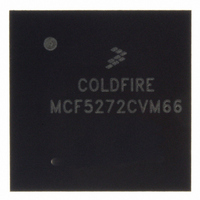MCF5272CVM66 Freescale Semiconductor, MCF5272CVM66 Datasheet - Page 103

MCF5272CVM66
Manufacturer Part Number
MCF5272CVM66
Description
IC MPU 66MHZ COLDFIRE 196-MAPBGA
Manufacturer
Freescale Semiconductor
Series
MCF527xr
Specifications of MCF5272CVM66
Core Processor
Coldfire V2
Core Size
32-Bit
Speed
66MHz
Connectivity
EBI/EMI, Ethernet, I²C, SPI, UART/USART, USB
Peripherals
DMA, WDT
Number Of I /o
32
Program Memory Size
16KB (4K x 32)
Program Memory Type
ROM
Ram Size
1K x 32
Voltage - Supply (vcc/vdd)
3 V ~ 3.6 V
Oscillator Type
External
Operating Temperature
-40°C ~ 85°C
Package / Case
196-MAPBGA
Cpu Speed
66MHz
Embedded Interface Type
UART, QSPI, USB, TDM
Digital Ic Case Style
BGA
No. Of Pins
196
Supply Voltage Range
3V To 3.6V
Rohs Compliant
Yes
Family Name
MCF5xxx
Device Core
ColdFire
Device Core Size
32b
Frequency (max)
66MHz
Instruction Set Architecture
RISC
Supply Voltage 1 (typ)
3.3V
Operating Temp Range
-40C to 85C
Operating Temperature Classification
Industrial
Mounting
Surface Mount
Pin Count
196
Package Type
MA-BGA
Lead Free Status / RoHS Status
Lead free / RoHS Compliant
Eeprom Size
-
Data Converters
-
Lead Free Status / Rohs Status
Compliant
Available stocks
Company
Part Number
Manufacturer
Quantity
Price
Company:
Part Number:
MCF5272CVM66
Manufacturer:
MOT
Quantity:
3
Company:
Part Number:
MCF5272CVM66
Manufacturer:
Freescale Semiconductor
Quantity:
10 000
Part Number:
MCF5272CVM66
Manufacturer:
FREESCALE
Quantity:
20 000
Company:
Part Number:
MCF5272CVM66J
Manufacturer:
NSC
Quantity:
36
Company:
Part Number:
MCF5272CVM66J
Manufacturer:
Freescale Semiconductor
Quantity:
10 000
- Current page: 103 of 544
- Download datasheet (7Mb)
Chapter 4
Local Memory
This chapter describes the MCF5272 implementation of the ColdFire Version 2 core local memory
specification. It consists of the following sections.
4.1
Depending on configuration information, instruction fetches and data read accesses may be sent
simultaneously to the SRAM, ROM, and cache controllers. This approach is required because the
controllers are memory-mapped devices and the hit/miss determination is made concurrently with the read
data access. Power dissipation can be minimized by configuring the ROM and SRAM base address
registers (ROMBAR and RAMBAR) to mask unused address spaces whenever possible.
If the access address is mapped into the region defined by the SRAM (and this region is not masked), it
provides the data back to the processor and any cache or ROM data is discarded. If the access address does
not hit the SRAM, but is mapped into the region defined by the ROM (and this region is not masked), the
ROM provides the data back to the processor and any cache data is discarded. Accesses from the SRAM
and ROM modules are never cached. The complete definition of the processor’s local bus priority scheme
for read references is as follows:
if (SRAM “hits”)
data
Freescale Semiconductor
•
•
Section 4.3, “SRAM
RAM (SRAM) and ROM implementations. These chapters cover general operations,
configuration, and initialization. They also provide information and examples showing how to
minimize power consumption when using the ROM and SRAM.
Section 4.5, “Instruction Cache
organization, configuration, and coherency. It describes cache operations and how the cache
interfaces with other memory structures.
Interactions Between Local Memory Modules
SRAM supplies data to the processor
if (ROM “hits”)
MCF5272 ColdFire
Overview,” and
ROM supplies data to the processor
®
Overview,” describes the cache implementation, including
else if (cache “hits”)
Integrated Microprocessor User’s Manual, Rev. 3
Section 4.4, “ROM
cache supplies data to the processor
else system memory reference to access
Overview,” describe the on-chip static
4-1
Related parts for MCF5272CVM66
Image
Part Number
Description
Manufacturer
Datasheet
Request
R
Part Number:
Description:
Mcf5272 Coldfire Integrated Microprocessor User
Manufacturer:
Freescale Semiconductor, Inc
Datasheet:

Part Number:
Description:
MCF5272 Interrupt Service Routine for the Physical Layer Interface Controller
Manufacturer:
Freescale Semiconductor / Motorola
Datasheet:
Part Number:
Description:
Manufacturer:
Freescale Semiconductor, Inc
Datasheet:
Part Number:
Description:
Manufacturer:
Freescale Semiconductor, Inc
Datasheet:
Part Number:
Description:
Manufacturer:
Freescale Semiconductor, Inc
Datasheet:
Part Number:
Description:
Manufacturer:
Freescale Semiconductor, Inc
Datasheet:
Part Number:
Description:
Manufacturer:
Freescale Semiconductor, Inc
Datasheet:
Part Number:
Description:
Manufacturer:
Freescale Semiconductor, Inc
Datasheet:
Part Number:
Description:
Manufacturer:
Freescale Semiconductor, Inc
Datasheet:
Part Number:
Description:
Manufacturer:
Freescale Semiconductor, Inc
Datasheet:
Part Number:
Description:
Manufacturer:
Freescale Semiconductor, Inc
Datasheet:
Part Number:
Description:
Manufacturer:
Freescale Semiconductor, Inc
Datasheet:
Part Number:
Description:
Manufacturer:
Freescale Semiconductor, Inc
Datasheet:
Part Number:
Description:
Manufacturer:
Freescale Semiconductor, Inc
Datasheet:
Part Number:
Description:
Manufacturer:
Freescale Semiconductor, Inc
Datasheet:











